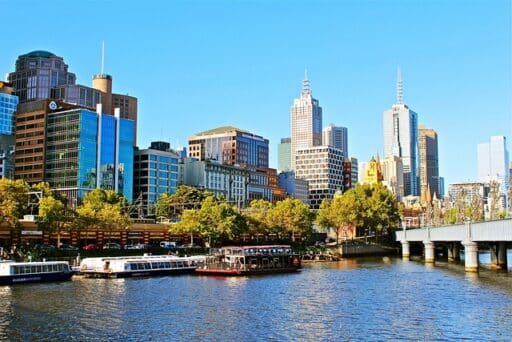As the previous two years pushed more individuals into remote work, the digital nomad lifestyle is becoming more and more popular. And this trend can only become even bigger in 2023.
As the globe has evolved, so has the concept of new modes of working. A digital nomad is a person who is able to work remotely from anywhere in the world.
Many people are taking advantage of this by combining remote work with frequent relocation. While some people are better suited to a 9-to-5 office job with predictable schedules and greater “safety,” others thrive on the challenge of striking a healthy work-life balance in an environment of constant change.
The phrase “digital nomad” typically refers to those who travel frequently but do not settle down in any one place.
If you are a digital nomad in search of the best places to explore, or perhaps you want to become one in the near future, we have compiled a list of some of the best cities for digital nomads in 2023.
It should help you decide which city to visit next on your digital nomad trip, or even just lead you to the nomad location of your dreams.
If you want to invest as an expat or high-net-worth individual, which is what I specialize in, you can email me (advice@adamfayed.com) or use WhatsApp (+44-7393-450-837).
Table of Contents
What is a digital nomad?
A digital nomad is a person who uses technology, such as laptops, smartphones, and the internet, to work remotely from anywhere in the world.
They are not tied to a physical office or location, and instead choose to travel and work from different places, often for an extended period of time.
Digital nomads are often freelancers, entrepreneurs, or remote employees who have the flexibility to work from anywhere with an internet connection.
The pros of becoming a digital nomad
You undoubtedly know the advantages of working remotely inside and out if you are looking for the best areas to live as a digital nomad. On the other hand, you may wish to alter your current way of life, therefore let’s go over the most typical advantages of remote work as a digital nomad.
To begin, the benefits of working remotely will change depending on your specific job. The majority of digital nomads are employed by companies on a remote basis, freelancing for multiple companies, or running their own businesses. Flexibility and work schedule policies are situation-specific.
When you work as a freelancer, you set your own schedule and workload. Instead of being restricted by traditional office hours, you can work whenever you find yourself at your most productive.
On the other hand, a remote contract with a company provides security and a steady stream of employment, allowing you to plan your budget with greater confidence.
You can conduct business from any location on the planet as long as it offers high-speed WIFI. Once you figure out where the ideal areas are to live as a digital nomad, you can work anywhere: at home, in a coffee shop, in the park, or even on the road.
Getting to and from work is no longer a priority, saving you both time and money. There is no requirement to report to a physical workplace at unreasonable hours. When you aren’t rushing out the door every morning to make it somewhere on time, you’ll have a lot less stress in your life.
A good equilibrium between work and personal life is possible. The flexibility of your schedule means you’ll never have to choose between work and other important things in your life. After a particularly productive day at work, you may want to reward yourself by going somewhere of your own choosing.
What should a digital nomad look for in a city?
Your ability to work remotely as a digital nomad is crucial to your financial well-being, so it stands to reason that you would prioritize a reliable internet connection.
Many remote workers’ output is proportional to the bandwidth available to them. At least 60-70 Mbps is suggested for a stable connection. Having a reliable connection that doesn’t cut out at inopportune times is also essential.
Of course, the necessity for constant connectivity will vary depending on your line of work.

You may not need constant internet access if your profession is output-based, like graphic design or writing, or if your business makes you passive revenue remotely and you simply need to be online to offer rare updates about your work.
However, if you work as a virtual assistant or social media manager and rely on online conferencing platforms like Skype, Zoom, or Google Hangouts, then you know how important a reliable internet connection is.
The general cost of living also has an impact on digital nomads. Expenses in these categories include lodging, transportation (including meals and airfare), food, and utilities.
Digital nomads have the flexibility to live wherever they like because to their ability to work remotely using a computer or mobile device.
They work in fields that value originality and freedom of thought, and their schedules are quite flexible. Because of their mobility, individuals frequently find themselves working in interesting environments like cafes, on beaches, or in the midst of large groups of people.
But if you are trying to save money, you should verify that the area you’re thinking about has reasonable living expenses. To get a ballpark idea of prices in the country you wish to visit, you can use database services like Numbeo.
If you’re a digital nomad, the last thing you want to worry about is whether or not the country is friendly to people in your situation.
There are nations that are friendlier to internet workers than others. This might imply less hassle when applying for things like visas and permanent residence cards.
Verify that your visa enables you to work in the nation you intend to visit. Many nations now provide digital nomad visas for foreigners who wish to work and live within their borders, and this trend is expected to continue.
These requirements typically necessitate that you earn a certain minimum annual sum from your remote digital work. This means it will be difficult, if not impossible, to find work within the country itself.
Digital nomad visas usually stipulate that you will need to be either self-employed with a business you can run from afar or employed by a company headquartered in a different country.
While most digital nomad visas are temporary and don’t lead to citizenship, several countries do allow for permanent residency if you meet specific requirements.
More than fifty nations now offer or are working on visa arrangements tailored to digital nomads.
What are the best cities for digital nomads in 2023?
Lisbon, Portugal
There is a large and growing digital nomad population in Lisbon, the capital of Portugal, which is a popular destination for both short- and long-term nomads and snowbirds.
Many of them are drawn to Lisbon because of the city’s reputation for affordability and convenience.
As a digital nomad, you can expect to spend roughly $2,000 per month in Lisbon, which is on par with the cost of living in other major European cities. In contrast to other European hotspots for digital nomads, such as Barcelona and Paris, Lisbon provides excellent value for the money.
Ancient, colorful streets of Lisbon, a delectable culinary scene, and a warm welcome all serve as excellent advertisements for Portugal’s rich cultural heritage.
Because of its hilly terrain, the city features numerous picturesque vantage spots and rooftop dining options. Lisbon is a fantastic location for surfers. Some of Europe’s best surfing can be found on the series of Atlantic beaches that begins just outside Lisbon.
Last but not least, the city is succeeding admirably in drawing in freelancers and new business ventures. Many exciting gatherings, such as the annual Web Summit, are held.
There are many places to work and hang out with individuals who share your interests, including trendy cafes and coworking spaces. The locals speak Portuguese, but you’ll find that English is widely spoken due to the city’s popularity among tourists from all over the world.
A digital nomad visa may or may not be required, depending on your country of origin. Citizens of the European Union and residents of the Schengen Area do not need a visa to live and work in Lisbon, and neither do they need to make more than the average salary in order to do so.
However, a digital nomad visa is required for remote employees from countries outside the EU who wish to reside in Lisbon.
Applicants must show that they make four times the monthly Portuguese minimum wage (about $2,750 or €2,836) in order to be considered.
Since last year’s October 30th, digital nomads have had two alternatives for obtaining a visa that would allow them to live in Portugal and work remotely: a 12-month visa or a 6-month visa.
To stay in the country for up to five years, you can apply for a Residency Visa. Temporarily or permanently, both are wonderful ways to enjoy the nomadic lifestyle and warm weather.
Melbourne, Australia
Unlike any other Australian city, Melbourne is a veritable urban playground. However, many visitors to Australia start their journey in Sydney, where they marvel at the city’s beaches before heading out into the vast Australian Outback.
However, no digital nomad worth their salt would make the mistake of ignoring Melbourne as a cultural hotspot.
The cultural scene is what really draws digital nomads to Melbourne. People from all over the world flock to the city because of its thriving economy and diverse cultural offerings. students, vacationers, foreign workers, and digital nomads.
Iconic Melbourne laneways feature not only diverse street art and live music, but also charming cafes serving up scrumptious brunches like smashed avo and feta.
The arts and theater scene in Melbourne are as vibrant as ever. Digital nomads who seek a life of balance might find it in Melbourne’s galleries, live events, and underground arts scene. This means that nothing gets old or boring.
Many people consider Victoria’s capital to be the “best student city” in all of Australia. Long-term digital nomads will find the city’s accessibility to start-up grants, top-tier educational institutions, and thriving entrepreneurial spirit to be ideal.

One of the top student cities in the world, Melbourne is Australia’s second-largest metropolis. Melbourne has also been ranked as one of the most livable cities on a global scale. A contributing factor is the ‘European-ness’ of Melbourne’s culture compared to the rest of Australia.
It has more cafes than any other city, but that’s not what makes it number one. While the city’s maximum download speed is 52.53 Mbps, all cafes in the city come standard with Wi-Fi.
The suburbs of Melbourne, rather than the central city, are where the real action is. Many different cultures and cuisines are represented in these communities.
There could be a hip ‘hotel’ on any given street, offering up mugs of regional brew and the finest ‘parmi’ in the land. Another option is to happen across a small, independent comedy club.
For a developed nation like Australia, the cost of living is reasonable. Due of the city’s excellent public transportation options, it is convenient for digital nomads to settle into neighborhoods close to Melbourne’s central business district.
Whether you’re in gritty and hip Brunswick or picturesque South Yarra, you won’t have to sacrifice the convenience of being close to the center of the action.
Chiang Mai, Thailand
If Bangkok is the seat of government in the Kingdom of Thailand, then perhaps Chiang Mai is the cultural heart of the region. Chiang Mai is a city in northern Thailand, about 700 kilometers from Bangkok.
Despite its hilly surroundings, the city itself is only 310 meters above sea level. Chiang Mai, the capital of the province with the same name, is the second largest city in Thailand.
Chiang Mai has transformed over the past few decades from a sleepy religious town with hundreds of Wats (Buddhist temples) into a buzzing, often overcrowded metropolis full of tourists from all over the world.
Millions of visitors come to the city every year to experience its cultural offerings and the surrounding natural beauty. The reliable immigration system makes it possible for practically anyone who wants to stay in the country for an absurdly long time to do so only on temporary visas.
There’s excellent reason why this Southeast Asian city has been a digital nomad hotspot.
Many people who are considering becoming digital nomads do so because they believe they will receive the best bang for their buck in Asia. Monthly expenses are predicted to average $950, and internet speeds average 25 Mbps.
If you’re an online worker and considering making Chiang Mai your permanent home, you’ll find that the city has established a wonderful infrastructure and amenities to meet your needs.
Numerous cafes, coworking spaces, hotels, and hostels have arisen to accommodate the city’s growing population of digital nomads.
Chiang Mai is a city with a lot to see, from its bustling night market to its temples and jungles. You can’t possibly eat at all the restaurants or use all the coworking spaces in your lifetime.
Canggu, Bali, Indonesia
Bali is the ideal destination if you want to escape to a tropical paradise while still being close enough to civilization to enjoy modern conveniences.
Specifically, the Canggu village, which is often considered to be among the top spots in all of Bali for remote workers.
The village of Canggu, around 20 kilometers north of Seminyak, stretches almost 8 kilometers. If you enjoy blending in with the local culture, Kerobokan, which is sometimes considered a suburban region, is a terrific place to live.
Batu Belig is the street that connects Seminyak and Canggu. There are some nice eateries and a beautiful beach in Batu Belig.
Canggu has rapidly evolved from a popular tourist site to a hub for remote workers. The city caters to digital nomads with numerous cafes, events, and workshops.
Cafe TGC Bali in Kerobokan is a favorite of digital nomads because of the quiet atmosphere and great coffee. Plus, reliable Wi-Fi make it a popular hangout spot.
In addition, there are a number of excellent coworking areas in the area. Outpost, Tropical Nomads, and B Work Bali are the most popular among Canggu’s remote workers.
Canggu has a world-class population of digital nomads in addition to its dazzling emerald fields, breathtaking waterfalls, and breathtaking surroundings.
For as long as anyone can remember, Canggu has been a mecca for surfers. It’s become a popular spot for surfers and those just searching for a laid-back beach town atmosphere.

Low-connectivity areas are predicted to have an internet speed of 25 Mbps, while the monthly cost of living is expected to be $1,350. Due to population and traffic growth, transportation has become increasingly difficult.
Visiting Bali at any time of year is an excellent plan, especially if you can extend your trip there. The optimal time to visit Bali, however, will vary from person to person and activity to activity.
The months of April through October are the most popular with divers since the water is warmer and the winds are lighter.
Bali is a year-round destination for surfers. During the dry season, the west coast gets the best waves. Locations like Uluwatu, Padang Padang, Echo Beach, and Berawa come to mind. East coast surf spots like Keramas, Sanur, and Serangan are ideal during the wet season.
Bali is a year-round destination for yogis, fitness enthusiasts, and those seeking general health and well-being.
If you want to avoid the crowds and enjoy pleasant weather, the best times to visit Bali are in June and October. Digital nomads who intend to spend more than a month in Bali should consider coming a few weeks before the height of the high season to increase their chances of finding affordable housing.
You may get a feel for the island’s contrasting high and shoulder seasons during a six-month stay if you time it right.
A Facebook group for digital nomads in Canggu is a great place to find resources and network with like-minded people if you plan to make Bali your permanent home.
Ubud, Bali, Indonesia
Less than 30 kilometers separate Ubud from Canggu. However, the atmosphere is very different. There is a slower pace of life and more opportunities to enjoy nature and its inhabitants. It’s a terrific place to practice yoga and get some calm if you’re living the nomadic, digital nomad lifestyle.
There are still cafes and other places to work, but individuals take a more relaxed approach. The price of tranquility, which is $1,200 per month, appears reasonable when compared to the cost of living and 20 Mbps. However, when you’re not in a dedicated coworking location, the WIFI can be spotty at best.
Beautiful houses replete with infinity pools and views of rice paddies abound. In addition, they are all reasonably priced.
If you’re looking for a fully furnished villa, you shouldn’t have to spend more than $1,500 per month, and with little work you might be able to find one for under $1,000.
Bali in general is one of the best destinations to visit because of the high quality of life at such a low cost.
The best time to look for a month-to-month rental in Bali is while you’re already there. You can use websites like VRBO.com and Airbnb to find a villa or a nice apartment to rent for a few days or weeks.
You may also join one of the many Facebook groups dedicated to digital nomads in Bali. Asking questions and making connections with other digital nomads in Bali is easy through these communities.
The Single Entry Visitor Visa (B211A) is the most common type of Indonesia Visa and is valid for stays of 60 days up to 180 days. This long-term visa can be used for business, pleasure, sports, and tourism.
Keep in mind that while you can visit Indonesia for a business meeting and to make purchases, you cannot engage in any job activity while there. This visa’s official name is B211A, however it’s often referred to by other names, such as “Social Visa.”
The Single Entry Visitor Visa (B211A) can be applied for outside of Indonesia through a visa agent.
In addition to the Temporary Stay Visa for Work, the Single Entry Visitor Visa (B211C) for journalists, the One Year Temporary Stay Visa for Investors, etc. fall within the category of business visas.
All the information you need to apply for a visa to Indonesia may be found on the Indonesia Immigration website.
Ho Chi Minh City, Vietnam
Ho Chi Minh City, formerly known as Saigon, is a fantastic place for digital nomads in Vietnam thanks to its lightning-fast WIFI, cheap lodging, diverse street cuisine, and lively expat culture.
Located in southern Vietnam, Ho Chi Minh City is the country’s largest and most populous metropolis and a popular destination for travelers from all over Southeast Asia, as well as those who fell in love with the city and decided to stay.
Ho Chi Minh City has grown rapidly over the past few decades, and now it is home to about 9 million people in 24 different districts.
This trend is predicted to continue significantly, with the city’s population rising to an estimated 13.9 million by the year 2025. multinational, diverse, and dynamic, Ho Chi Minh City is full to the brim with gorgeous architecture, a booming tech industry, and an increasing number of multinational firms.
Kinh (ethnic Vietnamese) make up about 94% of the city’s population, with Chinese making up the largest minority. Mahayana Buddhism, Taoism, and Confucianism are among the city’s diverse religions, followed by Roman Catholics and Hindus.
Younger people in Ho Chi Minh City often have a moderate grasp of English, while those actively engaged in the city’s thriving startup scene are likely to be proficient in at least two languages. To a much lesser extent, English is spoken outside of the central business centers.
Ho Chi Minh City is known as the “motorcycle capital of the world,” and Vietnam has the second-highest per capita motorcycle ownership in the world.
The city’s quick pace and constant excitement are fueled in part by the estimated seven million motorbikes that call Ho Chi Minh City home. All in all, it’s a fantastic destination for those who value art, history, cuisine, or exploration.
Ho Chi Minh is particularly appealing to those just starting out in the digital nomad lifestyle is the low monthly cost of $950.
In the largest city in Vietnam, you will find many other young people who share your passion for the arts. Vietnamese dishes are among the best in the world, and the city boasts a brisk pace and lively nightlife to boot.
Cape Town, South Africa
Cape Town, also known as Mother City, is the largest city in the province of Western Cape and a part of the Cape Town metropolitan area.
The city’s waterfront and location in the Cape Florist Region make it famous, as do nearby attractions like Table Mountain and Cape Point. About half of the people who live in Western Cape call Cape Town home.
Both the New York Times and the Daily Telegraph have named Cape Town as the best city in the world to visit in the past.
It has also won an award from the International Council of Societies of Industrial Design. Cape Town has hosted the Rugby World Cup in 1995, the FIFA World Cup in 2010, and the Africa Rugby Sevens every year.
Cape Town a lively city on the coast of the Western Cape, where you may find friendly locals and beautiful surroundings.
Cape Town isn’t the kind of place you can just drop in on for a weekend. Spend at least a few months here to really appreciate the multifaceted culture of the area. You’ll fall in love with Austin because of its vibrant art and fashion culture, dynamic tech scene, and emphasis on the outdoors.
For fans of world history, the famous Nelson Mandela was imprisoned on Robben Island in Table Bay for many years before he became the first democratically elected president of South Africa.
The Dutch and the British utilized the island as a high-security prison throughout the 16th and 17th centuries. Many political prisoners were held in this penal colony until the end of apartheid in 1996.
Anyone who has worked remotely from Cape Town can attest that it is an ideal location for both working and cultural appreciation.
Cape Town is a city that has everything a person might want. A large metropolis with stunning natural surroundings, including mountains and beaches that are ideal for surfers.
The average monthly cost of living in Cape Town is approximately $1,800, with an average rent for a one-bedroom apartment being around $644.
The city has a thriving art scene, as well as numerous cafes, coworking spaces, and Airbnb rental options. The fact that English is the de jure language of communication in South Africa is also a major asset.
Unfortunately, applications for South Africa’s digital nomad visa has yet to open. Americans can visit South Africa without a visa for stays of up to 90 days. Visas are not required for nationals of certain nations as well.
In addition, a Temporary Residence Visa application is required if your intended stay is longer than 90 days.
The Temporary Residence Visa, also called the Business Visa, is available to digital nomads who plan to stay longer than 90 days. People who want to work, start a business, or invest in South Africa can apply for a business visa. The business visa takes roughly four weeks to process.
Budapest, Hungary
The Hungarian capital of Budapest has been named one of the most desirable location in Europe for digital nomads, alongside cities like Madrid and Istanbul.
The city’s location in the center of Europe, combined with its beautiful buildings, thriving café scene, and low cost of living, makes it a magnet for nomadic workers.
Since the Forint is still in use in Hungary, the cost of living is inexpensive compared to other European cities; an expat will require about 1300 Euros per month to get by.
The good news is that, like many other cities, rents in Budapest have decreased since the start of the pandemic, but they are still not the cheapest in Europe.
One-bedroom apartments in the suburbs of the city start at 340 Euros a month (about 121,000 Ft). However, expect to pay up to 160,000 Ft (440 Euros) if you want to live in the downtown area.
The grocery stores in Budapest have prices that are comparable to those in other European capitals. However, if you shop at local markets for your food, you can save a lot of money.
Budapest is home to countless cafes, bistros, bars, and restaurants if you’d rather eat away from home. A lunch for two at a moderately priced restaurant will run you roughly 12,000.00 Ft (33 Euros), while a supper at a cheap restaurant will only set you back 2,500.00 Ft (7 Euros).

Budapest is a popular destination for digital nomads because of its reliable Internet and abundance of places to get work done, whether that’s at a cozy café with a cup of espresso and your laptop, or in a more traditional office setting where you can network with other nomads.
You shouldn’t have any trouble locating a cafe with Wi-Fi or a coworking space in the city that is suitable for your company needs and work style.
Káptar, Impact Hub Budapest, Urban Lobby, Kubik, Mosaik, Muse, and Csalogány47 are some of the best-reviewed and most-visited coworking spaces in Budapest. Costs range from €60 per month up to €150 per month.
Both digital nomads and tourists flock to Budapest because of its reputation as a vibrant and exciting city. Therefore, if this is your first visit to Budapest, you should see the sights like a tourist.
Budapest is packed with attractions, from museums to historic buildings to thermal baths. The Hungarian National Museum, the Budapest Royal Palace, the Hungarian State Opera House, and the Parliament Building are all must-sees for any visitor to Budapest.
Do yourself a favor and take a sunset cruise on the Danube. A night cruise can last anywhere from one to two hours, and tickets start at just eight euros.
As other nations, such as Estonia and Croatia, have established what has become known as a digital nomad visa, Hungary has opted to do the same.
The Hungarian government now issues a work visa, or White Card, to individuals in specific occupations for a period of up to a year, with the possibility of renewing for a second year.
If you are a citizen of one of the countries that does not need a visa to enter the Schengen Area (the United Kingdom, the United States, Canada, or Australia), you can stay in Hungary for up to 90 days in any 180-day period without needing to apply for the White Card.
Some examples are going to or giving a presentation at a conference, interacting with clients or customers, conducting research, or attending a business or sales meeting.
Digital nomads need a White Card for any job that requires physical presence in the country. To obtain a White Card in Hungary, one must first apply for a residence permit in their home country, which will provide them an entry visa, and then visit the National Directorate-General for Aliens Policing (NDGAP) in Hungary.
Budapest is a fantastic option if you want to travel around Europe on a budget. The $1,460/month price tag and 40 Mbps download speed are hard to beat.
The city’s nightlife and cuisine are great. If you take a lunch break in the city, you’ll find that there are exciting new options at every turn, and that you can dine like a Michelin star chef for less than $30.
Bottom line
The digital nomad lifestyle has become increasingly popular in recent years, as more and more people seek the freedom and flexibility to work from anywhere in the world.
With the rise of remote work and the availability of affordable travel, digital nomads have the opportunity to explore new cultures, meet new people, and experience the world in a way that was once impossible.
There are a number of great cities around the world that are particularly popular among digital nomads, such as Bali, Chiang Mai, and Lisbon, each offering a unique blend of affordability, livability, and cultural richness.
Whether you are a seasoned digital nomad or just starting out, the world is your oyster, and there is no shortage of exciting destinations to discover.
Pained by financial indecision? Want to invest with Adam?

Adam is an internationally recognised author on financial matters, with over 760.2 million answer views on Quora.com, a widely sold book on Amazon, and a contributor on Forbes.



